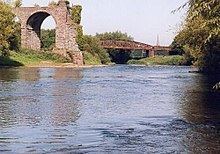Stations Seven Line length 13 mi (21 km) | Closed 1959 (1959) | |
 | ||
Opened 4 August 1873 (1873-08-04) Track gauge 1,435 mm (4 ft 8 ⁄2 in) | ||
The Ross and Monmouth Railway (sometimes referred to as the Wye Valley line) was a 4 ft 8 1⁄2 in (1,435 mm) standard gauge railway of 13 miles (21 km) which ran between Ross-on-Wye, in Herefordshire, England and Monmouth, Monmouthshire, Wales. It was authorized in 1865 by an Act of Parliament and opened on 4 August 1873. The station at Monmouth was situated at Mayhill on the east bank of the Wye; later, in 1874 the line was extended to a station at Monmouth Troy. The railway remained independent until 1921 when the 1921 Railways Act forced its amalgamation with the Great Western Railway.
Contents
History
Contractor was John Firbank who took eight years to construct the railway, which was opened on 4 August 1873, with its terminus initially at Monmouth Mayhill. The bridge over the River Wye was completed in 1874, a few months after the line's official opening ceremony. On the bridges completion the line was extended to Monmouth Troy, the extension was officially opened on 1 May 1874.
There were five stations on the 12 1⁄2 miles (20.1 km) long line, Ross-on-Wye (already constructed for the Hereford, Ross and Gloucester Railway), Kerne Bridge, Lydbrook Junction, Symonds Yat, Monmouth Mayhill and Monmouth Troy. Two halts were added later, one at Walford (opened in 1931) and the other at Hadnock (opened in 1951). Hadnock Halt was only open for eight years, it was closed in 1959 when passenger services were withdrawn from the line.
Route
Starting at Ross-on-Wye the line skirted around the southern outskirts of the town before heading west down the Wye valley on the river's south bank. The line passed through Walford, and Kerne Bridge then to avoid a long detour along a bend in the river crossed onto the opposite bank, went through a tunnel before recrossing the river. Here the line met the Severn and Wye Railway just before Lydbrook Junction. The line continued on the south bank of the Wye going through a tunnel just before Symonds Yat to avoid a three-mile bend, past Hadnock to Monmouth Mayhill and then Monmouth Troy.
Operations
From day one, the line was operated by the GWR under its company, the Monmouth and Hereford Railway. This allowed the GWR to run through trains from Monmouth via Ross on Wye, and onwards to Hereford via the Hereford, Ross and Gloucester Railway, without passengers having to change trains, or trains to change locomotives.
The Ross and Monmouth Railway was one of the few lines in Britain to remain independent until the Railways Act 1921 forced the GWR to take over the railway. It remained under the management of the GWR until the 'big four' railway companies were nationalised.
Closure
In January 1959 the Wye Valley Railway and the passenger services were withdrawn. The last ever passenger train was a 'special' service from Chepstow to Ross-on-Wye along both the Wye Valley and Ross and Monmouth Railways, the only known train to make the trip in one single journey. The section between Lydbrook and Monmouth was closed completely but the section between the Lower Lydbrook Viaduct and Ross-on-Wye remained open until 1 November 1965.
